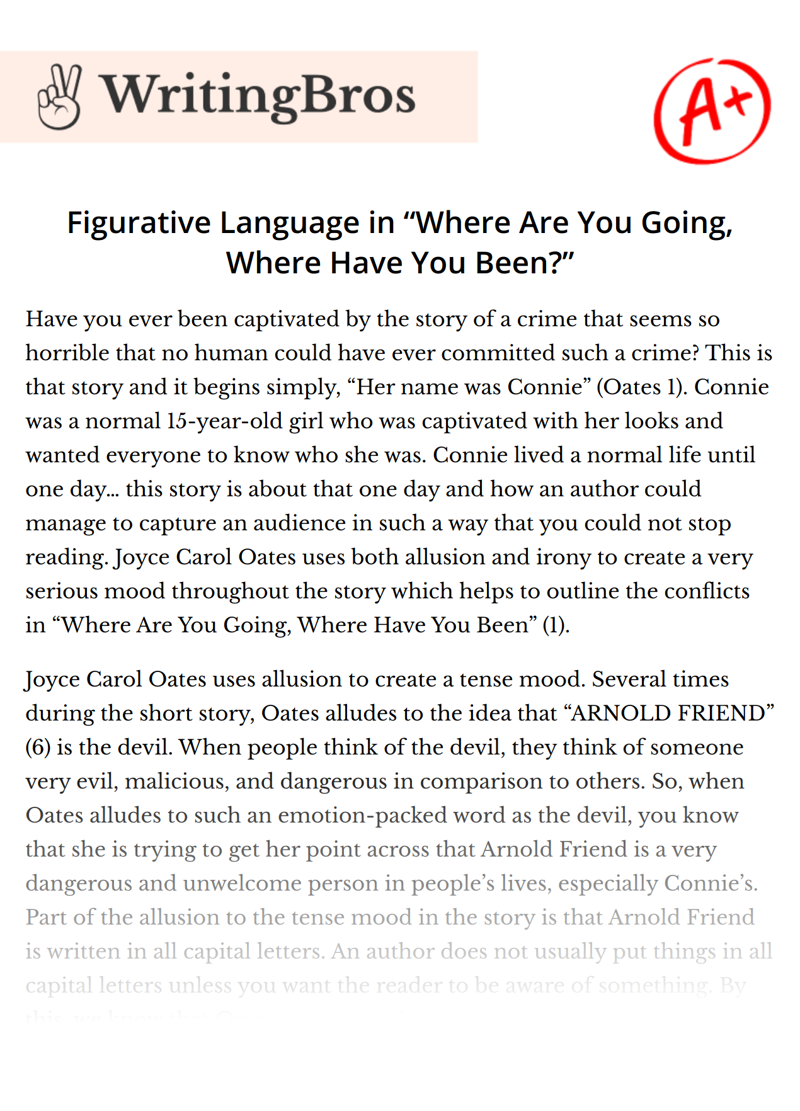Figurative Language in “Where Are You Going, Where Have You Been?”

Have you ever been captivated by the story of a crime that seems so horrible that no human could have ever committed such a crime? This is that story and it begins simply, “Her name was Connie” (Oates 1). Connie was a normal 15-year-old girl who was captivated with her looks and wanted everyone to know who she was. Connie lived a normal life until one day… this story is about that one day and how an author could manage to capture an audience in such a way that you could not stop reading. Joyce Carol Oates uses both allusion and irony to create a very serious mood throughout the story which helps to outline the conflicts in “Where Are You Going, Where Have You Been” (1).
Joyce Carol Oates uses allusion to create a tense mood. Several times during the short story, Oates alludes to the idea that “ARNOLD FRIEND” (6) is the devil. When people think of the devil, they think of someone very evil, malicious, and dangerous in comparison to others. So, when Oates alludes to such an emotion-packed word as the devil, you know that she is trying to get her point across that Arnold Friend is a very dangerous and unwelcome person in people’s lives, especially Connie’s. Part of the allusion to the tense mood in the story is that Arnold Friend is written in all capital letters. An author does not usually put things in all capital letters unless you want the reader to be aware of something. By this, we know that Oates wants us to be aware or even fear Arnold Friend not only because of his name itself but how it is written in the story. Another example of allusion that Arnold Friend is the devil is the phrase on the side of his car, “DONE BY CRAZY WOMAN DRIVER” (6). This is a phrase that is not funny to adults but is targeted at young kids. Arnold Friend’s tactic works because it makes Connie laugh. Oates wants us to ask ourselves why a grown man would have anything targeted towards teenagers on his car. Arnold is using the same tactic as the devil. He targets young people and gives them temptations so that they will come to his side and he can take control of them. This is his temptation, trying the make young kids laugh and put them at ease so they will become more friendly with him and think of him not as a danger, but as a friend. He gives his victims a false sense of security. Through allusion, we have the belief and concern that Arnold Friend is going to try and hurt Connie, creating a tense and uneasy mood in the story.
Oates also uses a figurative language called irony several times in the short story to help us outline and highlight the conflict between the characters. The first example of irony starts before we even read the first paragraph. It lies in the title, “Where Are You Going, Where Have You Been” (1). We hear these two questions constantly throughout childhood, but who we hear them from the most frequently is our parents who love us the most. When we are introduced to the dad of Connie’s friend, the most telling characteristic is “… when he came to pick them up again at eleven he never bothered to ask what they had done” (2). This is a clear, ironic reference to the title of the story because he never bothers to ask. When that question is not asked, we might begin to wonder what could happen as a result. Because no one asks Connie, including her family, she has gotten into serious trouble and now has Arnold Friend at her door trying to manipulate her into getting into his car and leave the safety of her home. Oates uses irony to create a tense mood and conflict. The author shows through irony, that no one, not even Connie’s parents, cares where she is going or where she has been. This is partly why she decides to leave the safety of her home for Arnold Friend.
We may not realize it, but the decisions we make every day, even the music we listen to and the movies and television shows we watch, have a big impact on determining how we live our lives. Connie makes decisions based on the people around her. Her choices lead to what he might assume to be her death. When Joyce Carol Oates uses the figurative language of allusion and irony, she quickly creates a very serious mood and outlines the conflict between the main characters. Although Arnold Friend never actually does anything evil, from the moment readers meet him, we believe that Connie is in danger. Although the crime about to be committed is horrific, the author through her words captivates us to continue through to the end.
Cite this Essay
To export a reference to this article please select a referencing style below

